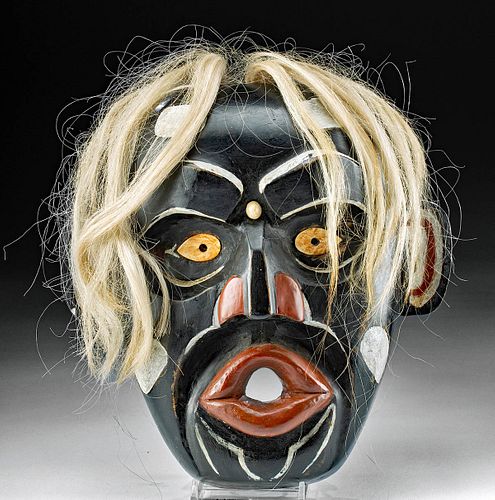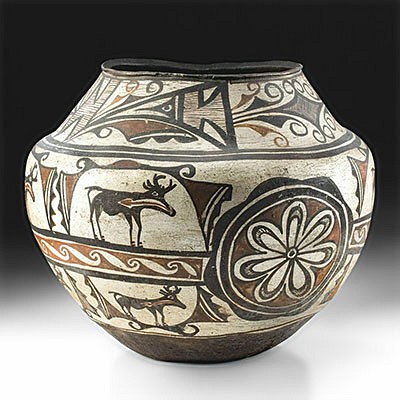1947 Haida Wood & Ivory Dzunukwa Mask, B. Williams
Lot 22
About Seller
Artemis Fine Arts
686 S Taylor Ave, Ste 106
Louisville, CO 80027
United States
Selling antiquities, ancient and ethnographic art online since 1993, Artemis Gallery specializes in Classical Antiquities (Egyptian, Greek, Roman, Near Eastern), Asian, Pre-Columbian, African / Tribal / Oceanographic art. Our extensive inventory includes pottery, stone, metal, wood, glass and textil...Read more
Estimate:
$4,500 - $6,750
Absentee vs Live bid
Two ways to bid:
- Leave a max absentee bid and the platform will bid on your behalf up to your maximum bid during the live auction.
- Bid live during the auction and your bids will be submitted real-time to the auctioneer.
Bid Increments
| Price | Bid Increment |
|---|---|
| $0 | $25 |
| $300 | $50 |
| $1,000 | $100 |
| $2,000 | $250 |
| $5,000 | $500 |
| $10,000 | $1,000 |
| $20,000 | $2,500 |
| $50,000 | $5,000 |
| $100,000 | $10,000 |
| $200,000 | $20,000 |
About Auction
By Artemis Fine Arts
Nov 18, 2021
Set Reminder
2021-11-18 10:00:00
2021-11-18 10:00:00
America/New_York
Bidsquare
Bidsquare : Art & Artifacts of North America
https://www.bidsquare.com/auctions/artemis-gallery/art-artifacts-of-north-america-7894
Join us for a special auction not to be missed! Collectible Native American art from antiquity to mid-20th century, Spanish Colonial, Latin American, Pre-Columbian, fine & folk art, American frontier items, fossils, and much more! Artemis Fine Arts info@artemisgallery.com
Join us for a special auction not to be missed! Collectible Native American art from antiquity to mid-20th century, Spanish Colonial, Latin American, Pre-Columbian, fine & folk art, American frontier items, fossils, and much more! Artemis Fine Arts info@artemisgallery.com
- Lot Description
Native American, Northwestern Canada, Haida, ca. 1947 CE. A stunning wood and walrus ivory mask of Dzunukwa (or Dzonokwa) or Wild Woman, skillfully hand-carved and painted by a Haida artist. This dark visage displays full pursed lips held open as though singing or chanting, a prominent nose with wide nostrils, sunken eyes, inlaid with carved walrus ivory that are pierced for the wearer to see through, and a central ivory knob between the thick brows. A series of 7 tufts of lengthy gray horsehair sprout from the top of the brow, cascading down the front of her face and accentuating her "wild" appearance. The verso is signed by an unknown artist, B. Williams. Size: 10" L x 10" W (25.4 cm x 25.4 cm)
Dzunukwa is a mythical female being said to cause nightmares and carry children away to her home in the forest to eat them. Like beasts such as Bigfoot or the Sasquatch, she is believed to be an anthropomorphic giant with a huge body and head, boney, black face, bushy unkempt hair, and pursed lips. Her prominent red lips, as seen in this example, are emphasized to indicate her blood thirstiness and her cry “Hu! Hu!” During the winter ceremonies, masked dancers represent several spiritual beings, including Dzunukwa, who is portrayed as shaggy, lumbering, sleepy, and vain. She always carries a basket to collect children and must be assisted by a rope that leads from the door to her seat when she enters the longhouse for the winter ceremony, due to her clumsiness. Though frightening, it is important to note that she is capable of providing wealth and power. If a chief wants his audience to respect and fear him, as they fear Dzunukwa, he wears her mask while speaking to the people. It is believed that those who are able to outsmart Dzunukwa and reach her house, will leave with treasures like dried meats, animal skins, dance privileges and the "water of life," which is capable of reviving the dead.
This is an ESA antique exempt piece of ivory and cannot be sold internationally or to anyone residing in the states of California, Hawaii, Illinois, Nevada, New Hampshire, New Jersey, New York, Oregon, and Washington. We guarantee that the piece was made prior to 1972.
This piece has been searched against the Art Loss Register database and has been cleared. The Art Loss Register maintains the world's largest database of stolen art, collectibles, and antiques.
Provenance: private Alamo collection, Alamo, California, USA, before 2000
All items legal to buy/sell under U.S. Statute covering cultural patrimony Code 2600, CHAPTER 14, and are guaranteed to be as described or your money back.
A Certificate of Authenticity will accompany all winning bids.
PLEASE NOTE: Due to recent increases of shipments being seized by Australian & German customs (even for items with pre-UNESCO provenance), we will no longer ship most antiquities and ancient Chinese art to Australia & Germany. For categories of items that are acceptable to ship to Australia or Germany, please contact us directly or work with your local customs brokerage firm.
Display stands not described as included/custom in the item description are for photography purposes only and will not be included with the item upon shipping.
#167284Ears reattached with adhesive residue. Surface wear and scuffs and chips to paint and wood. Some areas of discoloration. Stable pressure fissure on chin. Signed on verso with date. Metal wire added for suspension.Condition
- Shipping Info
-
All shipping is handled in-house for your convenience. Your invoice from Artemis Gallery will include shipping calculation instructions. If in doubt, please inquire BEFORE bidding for estimated shipping costs for individual items.
-
- Buyer's Premium



 EUR
EUR CAD
CAD AUD
AUD GBP
GBP MXN
MXN HKD
HKD CNY
CNY MYR
MYR SEK
SEK SGD
SGD CHF
CHF THB
THB














